PhraPikaned Ganesha statue Gold
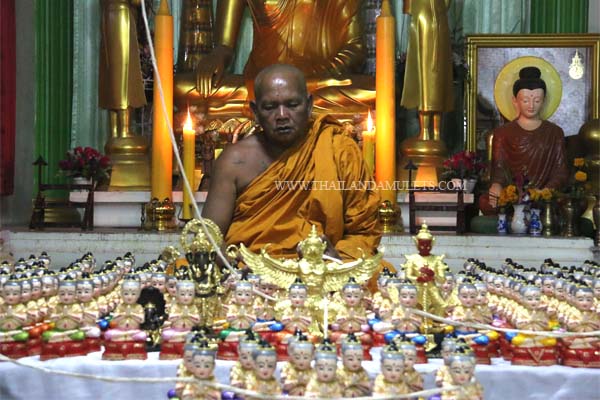
Gentle Ganesha, one of the most worship God. PhraPikaned is a god of art and success, destroyer of sins. Bring success to fortune, protection from dangers/misfortune, blessing through all obstacles in life's fortune.
Bless/chanted placing monastry's altar ceremony by Luangpor Teang, abbot of WatNongphong temple, guru monk of Thailand. Solo bless/chanted again by the monk. Blessing Ganesha statue with quality gold art work. Attached with PhraSretthi Navagothi amulet, 4 silver takruts craft with yant blessing mantras.
PhraPikaned - Ganesha
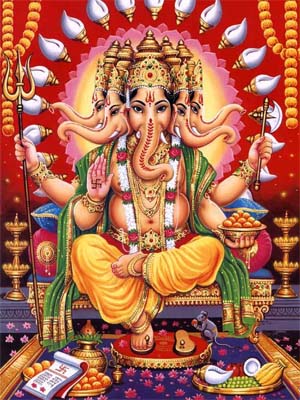
Ganesha � the elephant-deity riding a mouse � has become one of the commonest mnemonics for anything associated with Hinduism. This not only suggests the importance of Ganesha, but also shows how popular and pervasive this deity is in the minds of the masses.
The Lord of Success
The son of Shiva and Parvati, Ganesha has an elephantine countenance with a curved trunk and big ears, and a huge pot-bellied body of a human being. He is the Lord of success and destroyer of evils and obstacles. He is also worshipped as the god of education, knowledge, wisdom and wealth. In fact, Ganesha is one of the five prime Hindu deities (Brahma, Vishnu, Shiva and Durga being the other four) whose idolatry is glorified as the panchayatana puja.
Significance of the Ganesha Form
Ganesha's head symbolizes the Atman or the soul, which is the ultimate supreme reality of human existence, and his human body signifies Maya or the earthly existence of human beings. The elephant head denotes wisdom and its trunk represents Om, the sound symbol of cosmic reality. In his upper right hand Ganesha holds a goad, which helps him propel mankind forward on the eternal path and remove obstacles from the way. The noose in Ganesha's left hand is a gentle implement to capture all difficulties.
The broken tusk that Ganesha holds like a pen in his lower right hand is a symbol of sacrifice, which he broke for writing the Mahabharata. The rosary in his other hand suggests that the pursuit of knowledge should be continuous. The laddoo (sweet) he holds in his trunk indicates that one must discover the sweetness of the Atman. His fan-like ears convey that he is all ears to our petition. The snake that runs round his waist represents energy in all forms. And he is humble enough to ride the lowest of creatures, a mouse.
How Ganesha Got His Head
The story of the birth of this zoomorphic deity, as depicted in the Shiva Purana, goes like this: Once goddess Parvati, while bathing, created a boy out of the dirt of her body and assigned him the task of guarding the entrance to her bathroom. When Shiva, her husband returned, he was surprised to find a stranger denying him access, and struck off the boy's head in rage. Parvati broke down in utter grief and to soothe her, Shiva sent out his squad (gana) to fetch the head of any sleeping being who was facing the north. The company found a sleeping elephant and brought back its severed head, which was then attached to the body of the boy. Shiva restored its life and made him the leader (pati) of his troops. Hence his name 'Ganapati'. Shiva also bestowed a boon that people would worship him and invoke his name before undertaking any venture.
However, there's another less popular story of his origin, found in the Brahma Vaivarta Purana: Shiva asked Parvati to observe the punyaka vrata for a year to appease Vishnu in order to have a son. When a son was born to her, all the gods and goddesses assembled to rejoice on its birth. Lord Shani, the son of Surya (Sun-God), was also present but he refused to look at the infant. Perturbed at this behaviour, Parvati asked him the reason, and Shani replied that his looking at baby would harm the newborn. However, on Parvati's insistence when Shani eyed the baby, the child's head was severed instantly. All the gods started to bemoan, whereupon Vishnu hurried to the bank of river Pushpabhadra and brought back the head of a young elephant, and joined it to the baby's body, thus reviving it.
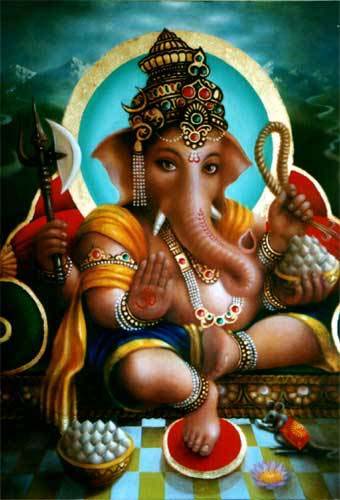
Ganesha, the Destroyer of Pride
Ganesha is also the destroyer of vanity, selfishness and pride. He is the personification of material universe in all its various magnificent manifestations. "All Hindus worship Ganesha regardless of their sectarian belief," says D N Singh in A Study of Hinduism. "He is both the beginning of the religion and the meeting ground for all Hindus."
Ganapati or Genesha, the Lord of Categories: All that can be counted or comprehended is a category (gana). The principle of all the classifications through which the relations between different orders of things, between the macrocosm and the microcosm, can be understood is called the lord-of-categories (Ganapati).
I bow to you, lord of categories. You alone are the visible form of the principle. You alone are the creator, you alone are the sustainer, you alone are the destroyer, you alone are unmistakably the Principle-of-All (Brahma), the true Self.
Ganesha or Ganapati is an extremely popular God in India. He is called Vighneshvara or Vighnaharta, the Lord of and destroyer of obstacles. People mostly worship Him asking for siddhi, success in undertakings, and buddhi, intelligence. He is worshipped before any venture is started. He is also the God of education, knowledge and wisdom, literature, and the fine arts.
Ganesha is also one of the five Gods the worship of whom was popularised by Adi Shankaracharya; the other four are Vishnu, Shiva, Devi and Surya. The worship of these five deities is called the pancAyatana pUjA. In some cases, a sixth God, Skanda is also worshipped.
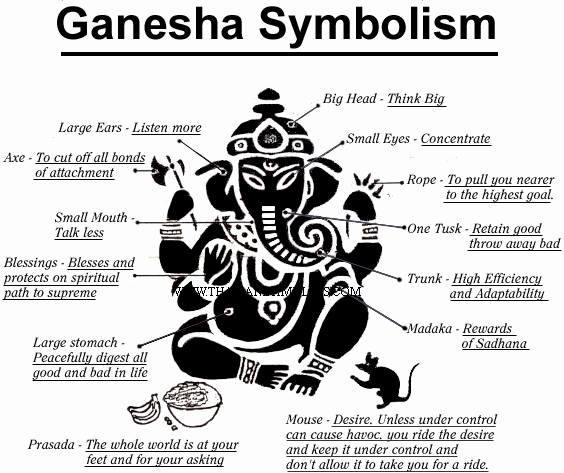
Ganesha's elephantine head and human body are explained as follows in the Mudgala Purana:
Ganesha's human body representing 'tvam', His elephantine countenance representing 'tat' and their joining together signifies the nondifference of 'tvam' (You) and 'tat' (Brahman). Thus, the body of Ganesha is the visible representation of the highest reality, Brahman, realised from 'tat tvam asi'.
Another explanation has it that Ganesha's head signifies Atman the Highest Reality, while the body below the neck represents mAyA, the principle of phenomenal existence. The Atman's involvement with the world is characterised by the assumption of mind and speech.
Ganesha's ears, which appear like large winnowing baskets, have a philosophical significance too. Just as one uses a winnowing basket to separate grains from dirt, one must use discrimination (viveka) to separate the real (Brahman) from the unreal (mAyA) in life. Here the grains stand for Brahman and the dirt signifies mAyA. Or, Ganesha's ears indicate that such discrimination between Brahman and mAyA is to be gained by taking recourse to SravaNa or hearing. Listening to the scriptures from a Guru will lead to proper discrimination and Brahman realisation.
Perhaps the most popular story regarding Ganesha's origin is the one derived from the Shiva Purana. Mother Parvati once wanted to take a bath and created a boy from the dirt of Her own body, asking him to stand as a guard outside while She bathed. In the meantime Lord Shiva returned home to find a stranger at His door, preventing Him from entering. In anger, Shiva cut off the boy's head, upon which Parvati was stricken with great grief. In order to console Her, Shiva sent out His troops (gaNa) to fetch the head of anyone found sleeping with his head pointing to the north. They found an elephant sleeping thus and brought back its head.
Shiva then attached the elephantine head to the body of the boy and revived him. He named the boy Ganapati or commander of His troops, and granted Him a boon that anyone would have to worship Him (Ganesha) before beginning any undertaking.
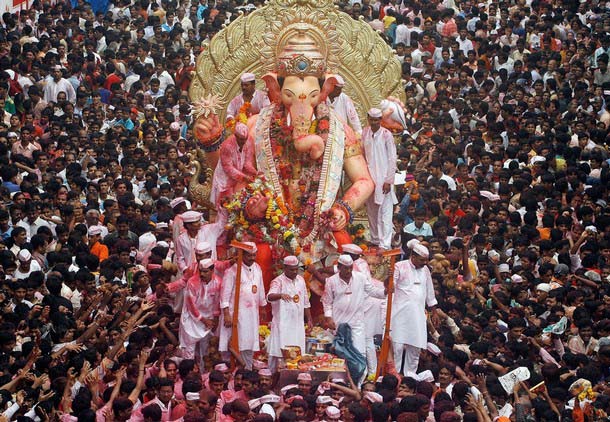
The Brahma vaivarta Purana narrates a different story regarding the origin of Ganapati. Shiva instructed Parvati, who wanted to have a son, to observe the puNyaka vrata for a year to propitiate Vishnu.
O Beautiful Goddess! Perform the worship of Hari by observing the punyaka vrata for a year. The Lord of Gopikas, the Lord of all creatures, Krishna Himself will be born as your son, as a result of the vrata.
On completion of the vrata by Parvati, it was announced that Krishna would incarnate Himself as Her son in every kalpa. Accordingly, Krishna was born as a charming infant, delighting Parvati who celebrated the event with great enthusiasm.
All the Gods arrived to have a look at the baby. But Shani, the son of Surya, did not look at him and stared at the ground instead. Upon Parvati's questioning regarding his behaviour, Shani said that his look would harm the baby. Parvati, however, insisted that he should look at the baby. In deference to Her wish Shani cast his eyes on the baby. Due to his malevolent glance, the baby's head was severed and flew to Goloka, the abode of Krishna. Parvati and all the Gods assembled there, including Shiva, were grief-stricken.
Thereupon, Vishnu mounted Garuda and rushed to the banks of the Pushpa-bhadra river and brought back the head of a young elephant. The head of the elephant was joined with the headless body of Parvati's son, reviving him. All the Gods blessed Ganesha and wished Him power and prosperity. Vishnu blessed Ganesha thus:
O Excellent God! O dear one! May Your pUjA be performed before that of any other God. May You be situated in all venerable beings and may You be the best among Yogis. This is My boon to You.
Shiva made Ganesha the leader of his troops (gaNa), and also gave Him the following boon:
All obstacles, whatever they may be, will be rooted out by worshipping Ganesha, even as diseases are cured by the worship of Surya and purity results when Vishnu is worshiped.
Excerpted from an article by Anand Hudli (ahudli@silver.ucs.indiana.edu).
It is said that anyone who looks at the moon on the night of the Ganesh Chaturthi will be falsely charged with theft or a similar crime. If someone inadvertently sees the moon on this night, he/she may remedy the situation by listening to (or reciting) the story of the syamantaka jewel. This story may be found in the Puranas such as the Bhagavata and the Vishnu. Briefly, Satrajit, who secured a jewel syamantaka from Surya, did not part with it even when Krishna the Lord of Dvaraka, asked for it saying it would be safe with Him. Prasena, the brother of Satrajit went out hunting wearing the jewel but was killed by a lion. Jambavan of Ramayana fame killed the lion and gave it to his son to play with. When Prasena did not return, Satrajit falsely accused Krishna of killing Prasena for the sake of the jewel.
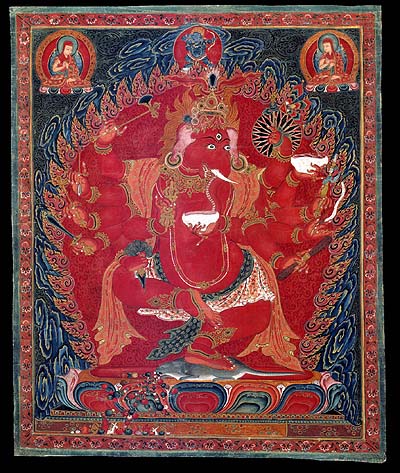
Krishna, in order to remove the stain on His reputation, set out in search of the jewel and found it in Jambavan's cave, with his child. Jambavan attacked Krishna thinking Him to be an intruder who had come to take away the jewel. They fought each other for 28 days, when Jambavan, his whole body terribly weakened from the hammering of Krishna's fists, finally recognised Him as Rama.
I now know You. You are the life in all creatures, virility, grit and strength. You are Vishnu, the Primeval Lord, All-prevailing, the Supreme Lord (of the worlds). (Bhagavata 10.56.26)
He Who built a bridge (across the ocean) that is a standing monument to His fame, set Lanka ablaze, and with His arrows severed the heads of Rakshasas, which fell to the ground.
As repentance for his having fought Krishna, Jambavan gave Krishna the jewel and also his daughter Jambavati in marriage. Krishna returned to Dvaraka with Jambavati and the jewel, and returned it Satrajit, who in turn repented for his false accusation. He promptly offered to give Krishna the jewel and his daughter Satyabhama in marriage. Krishna accepted Satyabhama as His wife but did not accept the jewel.
In the event one is not even able to listen to or read the story, the following mantra may be recited holding some water in the palm of the right hand. The water is then to be sipped.
A lion killed Prasena; the lion was killed by Jambavan. Don't cry, O dear child! This syamantaka jewel is yours.
The best of Thailand Buddha Statues/Amulets at
www.thailandamulets.com / www.thailandamulet.com










